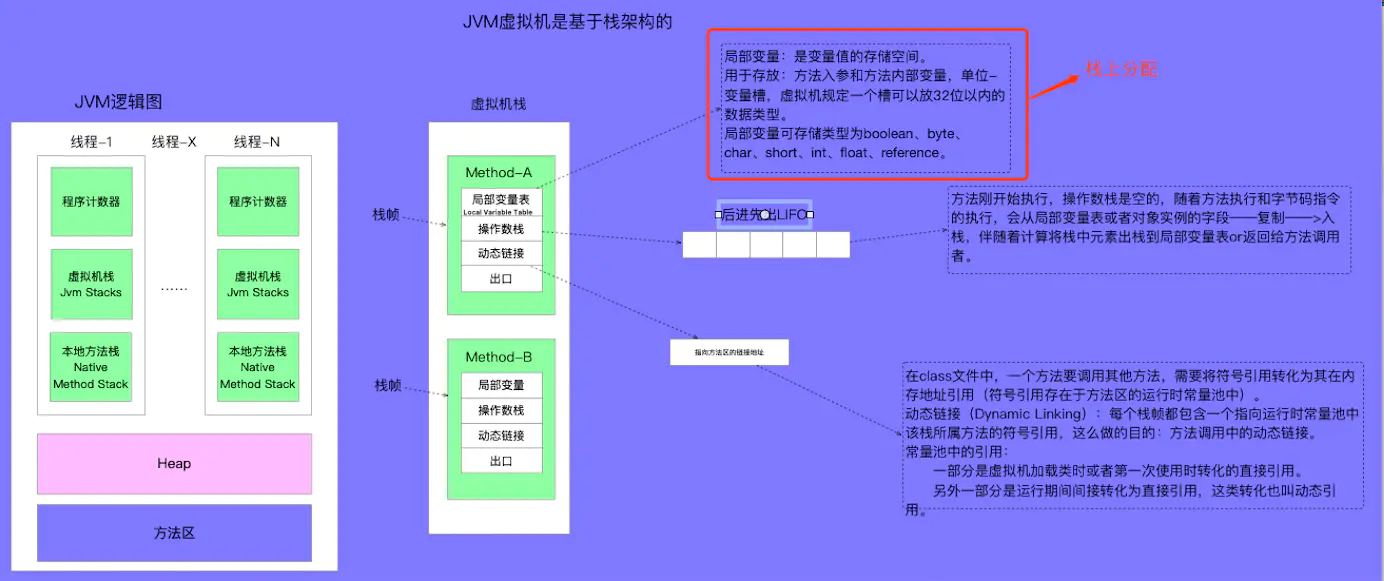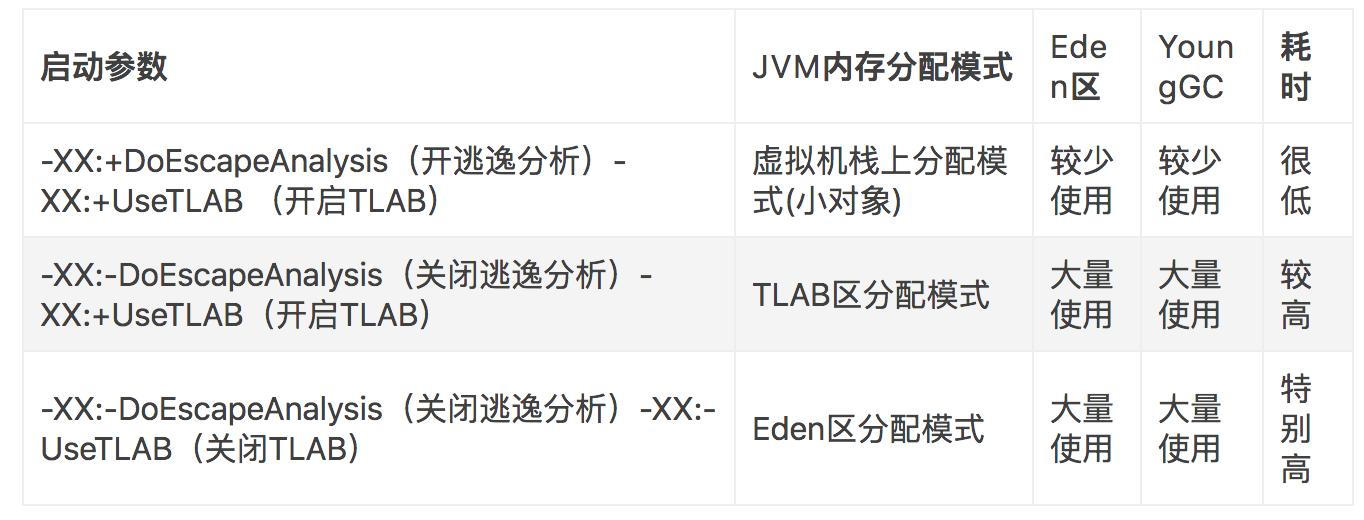「作者推荐」【JVM性能优化】对象内存分配之虚拟机参数调优分析
2021/7/2 7:25:22
本文主要是介绍「作者推荐」【JVM性能优化】对象内存分配之虚拟机参数调优分析,对大家解决编程问题具有一定的参考价值,需要的程序猿们随着小编来一起学习吧!
## 内容简介 > 本文主要针对于综合层面上进行分析JVM优化方案总结和列举调优参数计划。主要包含: - **调优之逃逸分析(栈上分配)** - **调优之线程局部缓存(TLAB)** - **调优之G1回收器** ## 栈上分配与逃逸分析 > **-XX:+DoEscapeAnalysis** ### 逃逸分析(Escape Analysis) **逃逸分析的基本行为就是分析对象动态作用域:当一个对象在方法中被定义后,它可能被外部方法所引用,称为方法逃逸。** 方法逃逸的几种方式如下: ```java public class EscapeTest { public static Object obj; // 给全局变量赋值,发生逃逸 public void globalVariableEscape() { obj = new Object(); } // 方法返回值,发生逃逸 public Object methodEscape() { return new Object(); } // 实例引用发生逃逸 public void instanceEscape() { test(this); } } ``` ### 栈上分配 > **栈上分配是Java虚拟机提供的一种优化技术** #### 基本思想 > "**对于那些线程私有的对象(指的是不可能被其他线程访问的对象),可以将它们直接分配在栈上,而不是分配在堆上**"。 > **分配在栈上的好处:可以在函数调用结束后自行销毁,而不需要垃圾回收器的介入,减轻GC压力,从而提升系统的性能**。 #### 使用场景 ##### 线程私有对象 - **受虚拟机栈空间的约束,适用小对象,大对象无法触发虚拟机栈上分配。** - **线程私有变量,大对象虚拟机会分配到TLAB中,TLAB(Thread Local Allocation Buffer)** - **在栈上分配该对象的内存,当栈帧从Java虚拟机栈中弹出,就自动销毁这个对象。减小垃圾回收器压力。** ## 虚拟机内存逻辑图  ### JVM内存分配源码: new关键字直接进行分配内存机制,源码如下: ```java CASE(_new): { u2 index = Bytes::get_Java_u2(pc+1); ConstantPool* constants = istate->method()->constants(); // 如果目标Java类已经解析 if (!constants->tag_at(index).is_unresolved_klass()) { // Make sure klass is initialized and doesn't have a finalizer Klass* entry = constants->slot_at(index).get_klass(); assert(entry->is_klass(), "Should be resolved klass"); Klass* k_entry = (Klass*) entry; assert(k_entry->oop_is_instance(), "Should be InstanceKlass"); InstanceKlass* ik = (InstanceKlass*) k_entry; // 如果符合快速分配场景 if ( ik->is_initialized() && ik->can_be_fastpath_allocated() ) { size_t obj_size = ik->size_helper(); oop result = NULL; // If the TLAB isn't pre-zeroed then we'll have to do it bool need_zero = !ZeroTLAB; if (UseTLAB) { result = (oop) THREAD->tlab().allocate(obj_size); } // 如果TLAB分配失败,就在Eden区分配 if (result == NULL) { need_zero = true; // Try allocate in shared eden retry: // 指针碰撞分配 HeapWord* compare_to = *Universe::heap()->top_addr(); HeapWord* new_top = compare_to + obj_size; if (new_top <= *Universe::heap()->end_addr()) { if (Atomic::cmpxchg_ptr(new_top, Universe::heap()->top_addr(), compare_to) != compare_to) { goto retry; } result = (oop) compare_to; } } if (result != NULL) { // Initialize object (if nonzero size and need) and then the header // TLAB区清零 if (need_zero ) { HeapWord* to_zero = (HeapWord*) result + sizeof(oopDesc) / oopSize; obj_size -= sizeof(oopDesc) / oopSize; if (obj_size > 0 ) { memset(to_zero, 0, obj_size * HeapWordSize); } } if (UseBiasedLocking) { result->set_mark(ik->prototype_header()); } else { result->set_mark(markOopDesc::prototype()); } result->set_klass_gap(0); result->set_klass(k_entry); // 将对象地址压入操作数栈栈顶 SET_STACK_OBJECT(result, 0); // 更新程序计数器PC,取下一条字节码指令,继续处理 UPDATE_PC_AND_TOS_AND_CONTINUE(3, 1); } } } // Slow case allocation // 慢分配 CALL_VM(InterpreterRuntime::_new(THREAD, METHOD->constants(), index), handle_exception); SET_STACK_OBJECT(THREAD->vm_result(), 0); THREAD->set_vm_result(NULL); UPDATE_PC_AND_TOS_AND_CONTINUE(3, 1); } ``` ### 代码总体逻辑 > **JVM再分配内存时,总是优先使用快分配策略,当快分配失败时,才会启用慢分配策略**。 1. 如果Java类没有被解析过,直接进入慢分配逻辑。 2. 快速分配策略,**如果没有开启栈上分配或者不符合条件则会进行TLAB分配。** 3. **快速分配策略,如果TLAB分配失败,则尝试Eden区分配。** 4. **如果Eden区分配失败,则进入慢分配策略。** 5. **如果对象满足直接进入老年代的条件,那就直接进入老年代分配。** 6. **快速分配,对于热点代码,如果开启逃逸分析,JVM自会执行栈上分配或者标量替换等优化方案**。 ## 在某些场景使用栈上分配 ### 设置JVM运行参数: >-Xmx10m -Xms10m -XX:+DoEscapeAnalysis -XX:-UseTLAB -XX:+PrintGC ### 开启逃逸模式,关闭TLAB ```java /** * @description 开启逃逸模式,关闭线程本地缓存模式(TLAB)(jdk1.8默认开启) * -Xmx10m -Xms10m -XX:+DoEscapeAnalysis -XX:-UseTLAB -XX:+PrintGC */ public class AllocationOnStack { public static void main(String[] args) throws InterruptedException { long start = System.currentTimeMillis(); for (int index = 0; index < 100000000; index++) { allocate(); } long end = System.currentTimeMillis(); System.out.println((end - start)+" ms"); Thread.sleep(1000*1000); // 看后台堆情况,来佐证关闭逃逸优化后,是走的堆分配。 } public static void allocate() { byte[] bytes = new byte[2]; bytes[0] = 1; bytes[1] = 1; } } ``` ### 运行结果 ```` [GC (Allocation Failure) 2048K->520K(9728K), 0.0008938 secs] [GC (Allocation Failure) 2568K->520K(9728K), 0.0006386 secs] 6 ms ```` > jstat -gc pid #### 查看内存使用情况:  ### 结论 > **看出栈上分配机制的速度非常快,只需要6ms就完成了实现GC** ### 调整JVM运行参数 ### 关闭逃逸模式,开启TLAB > **-Xmx10m -Xms10m -XX:-DoEscapeAnalysis -XX:+UseTLAB -XX:+PrintGC** #### 查看内存使用情况:  #### 运行结果 ```` [GC (Allocation Failure) 2048K->504K(9728K), 0.0013831 secs] [GC (Allocation Failure) 2552K->512K(9728K), 0.0010576 secs] [GC (Allocation Failure) 2560K->400K(9728K), 0.0022408 secs] [GC (Allocation Failure) 2448K->448K(9728K), 0.0006095 secs] [GC (Allocation Failure) 2496K->416K(9728K), 0.0010540 secs] [GC (Allocation Failure) 2464K->464K(8704K), 0.0007620 secs] [GC (Allocation Failure) 1488K->381K(9216K), 0.0007714 secs] [GC (Allocation Failure) 1405K->381K(9216K), 0.0004409 secs] [GC (Allocation Failure) 1405K->381K(9216K), 0.0004725 secs] ....... [GC (Allocation Failure) 2429K->381K(9728K), 0.0008293 secs] [GC (Allocation Failure) 2429K->381K(9728K), 0.0009006 secs] [GC (Allocation Failure) 2429K->381K(9728K), 0.0005553 secs] [GC (Allocation Failure) 2429K->381K(9728K), 0.0005077 secs] 894 ms ```` ### 结论 > **可以看出来,关闭了栈上分配后,不但YGC次数增加了,并且总体事件也变长了,总体事件894ms** ## 调整JVM运行参数 >**-Xmx10m -Xms10m -XX:-DoEscapeAnalysis -XX:-UseTLAB -XX:+PrintGC** ### 关闭逃逸,关闭TLAB ### 运行结果 ```` [GC (Allocation Failure) 2048K->472K(9728K), 0.0007073 secs] [GC (Allocation Failure) 2520K->528K(9728K), 0.0009216 secs] [GC (Allocation Failure) 2576K->504K(9728K), 0.0005897 secs] [GC (Allocation Failure) 2551K->424K(9728K), 0.0005780 secs] [GC (Allocation Failure) 2472K->440K(9728K), 0.0006923 secs] [GC (Allocation Failure) 2488K->456K(8704K), 0.0006277 secs] [GC (Allocation Failure) 1480K->389K(9216K), 0.0005560 secs] ....... [GC (Allocation Failure) 2437K->389K(9728K), 0.0003227 secs] [GC (Allocation Failure) 2437K->389K(9728K), 0.0004264 secs] [GC (Allocation Failure) 2437K->389K(9728K), 0.0004396 secs] [GC (Allocation Failure) 2437K->389K(9728K), 0.0002773 secs] [GC (Allocation Failure) 2437K->389K(9728K), 0.0002766 secs] 1718 ms ```` #### 查看内存使用情况:  ## 运行结果对比 1. 运行耗时(开启逃逸 VS关闭逃逸(开启TLAB)VS关闭逃逸(关闭TLAB)): 6ms VS 894ms VS 1718ms 2. 虚拟机内存&回收(开启逃逸VS关闭逃逸):   ## 调整分配空间大小 ```java /** * @since 2019/8/13 上午6:55 * -Xmx10m -Xms10m -XX:-DoEscapeAnalysis -XX:+UseTLAB -XX:+PrintCommandLineFlags -XX:+PrintGC */ public class AllocationOnStack { private static final int _1B = 65; public static void main(String[] args) throws InterruptedException { long start = System.currentTimeMillis(); for (int index = 0; index < 100000000; index++) { allocateBigSpace(); } long end = System.currentTimeMillis(); System.out.println(end - start); Thread.sleep(1000*1000); // 看后台堆情况,来佐证关闭逃逸优化后,是走的堆分配。 } public static void allocate() { byte[] bytes = new byte[2]; bytes[0] = 1; bytes[1] = 1; } public static void allocateBigSpace() { byte[] allocation1; allocation1 = new byte[1 * _1B]; } } ``` ### 运行结果 ```` -XX:+DoEscapeAnalysis -XX:InitialHeapSize=5242880 -XX:MaxHeapSize=5242880 -XX:+PrintCommandLineFlags -XX:+PrintGC -XX:+UseCompressedClassPointers -XX:+UseCompressedOops -XX:+UseParallelGC -XX:-UseTLAB ```` ```` [GC (Allocation Failure) 1023K->516K(5632K), 0.0028410 secs] [GC (Allocation Failure) 1540K->578K(5632K), 0.0023265 secs] ........ [GC (Allocation Failure) 2466K->1442K(5632K), 0.0013395 secs] [GC (Allocation Failure) 2466K->1442K(5632K), 0.0004367 secs] 8925 ```` > **调整启动参数: -XX:+DoEscapeAnalysis -XX:-UseTLAB** 运行结果: ```` -XX:+DoEscapeAnalysis -XX:InitialHeapSize=5242880 -XX:MaxHeapSize=5242880 -XX:+PrintCommandLineFlags -XX:+PrintGC -XX:+UseCompressedClassPointers -XX:+UseCompressedOops -XX:+UseParallelGC -XX:-UseTLAB ```` ```` [GC (Allocation Failure) 1023K->516K(5632K), 0.0028410 secs] [GC (Allocation Failure) 1540K->578K(5632K), 0.0023265 secs] ........ [GC (Allocation Failure) 2466K->1442K(5632K), 0.0013395 secs] [GC (Allocation Failure) 2466K->1442K(5632K), 0.0004367 secs] 8925 ```` ### 经过对比得出结论: 分配内存为>64byte == -XX:-UseTLAB 经过多次测试发现当_1B=64b时效率还是非常高,一旦大于64b就会急剧下降。所以推断出64byte是JVM选择是TLAB分配 OR Eden区分配的临界值。 ## TLAB的基本介绍 ### TLAB(Thread Local Allocation Buffer) > **线程本地分配缓存,这是一个线程独享的内存分配区域。** ### 特点 - TLAB解决了:**直接在线程共享堆上安全分配带来的线程同步性能消耗问题(解决了指针碰撞)**。 - TLAB内存空间位于Eden区。 - 默认TLAB大小为占用Eden Space的1%。 ### 开启TLAB的参数 - -XX:+UseTLAB - -XX:+TLABSize - -XX:TLABRefillWasteFraction - -XX:TLABWasteTargetPercent - -XX:+PrintTLAB ### TLAB的源码 #### TLAB的数据结构 ```c class ThreadLocalAllocBuffer: public CHeapObj这篇关于「作者推荐」【JVM性能优化】对象内存分配之虚拟机参数调优分析的文章就介绍到这儿,希望我们推荐的文章对大家有所帮助,也希望大家多多支持为之网!
- 2024-11-26Mybatis官方生成器资料详解与应用教程
- 2024-11-26Mybatis一级缓存资料详解与实战教程
- 2024-11-26Mybatis一级缓存资料详解:新手快速入门
- 2024-11-26SpringBoot3+JDK17搭建后端资料详尽教程
- 2024-11-26Springboot单体架构搭建资料:新手入门教程
- 2024-11-26Springboot单体架构搭建资料详解与实战教程
- 2024-11-26Springboot框架资料:新手入门教程
- 2024-11-26Springboot企业级开发资料入门教程
- 2024-11-26SpringBoot企业级开发资料详解与实战教程
- 2024-11-26Springboot微服务资料:新手入门全攻略





